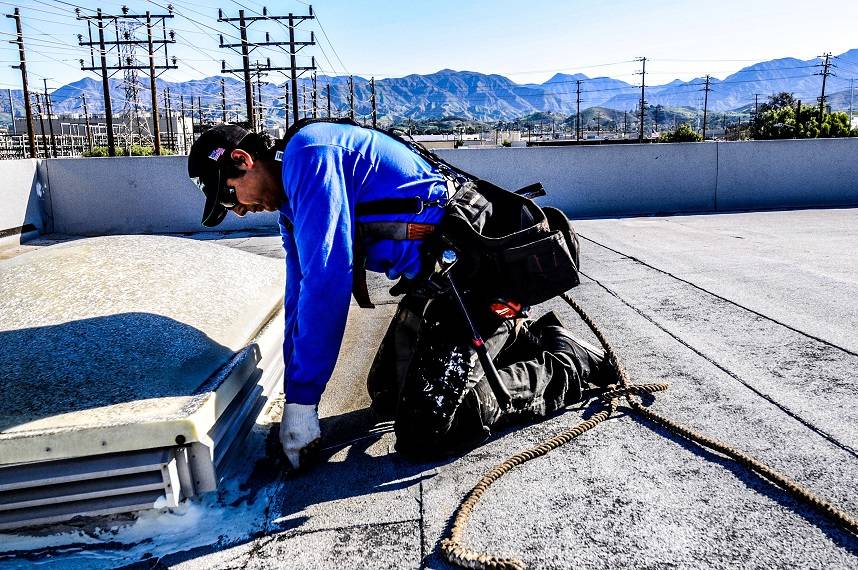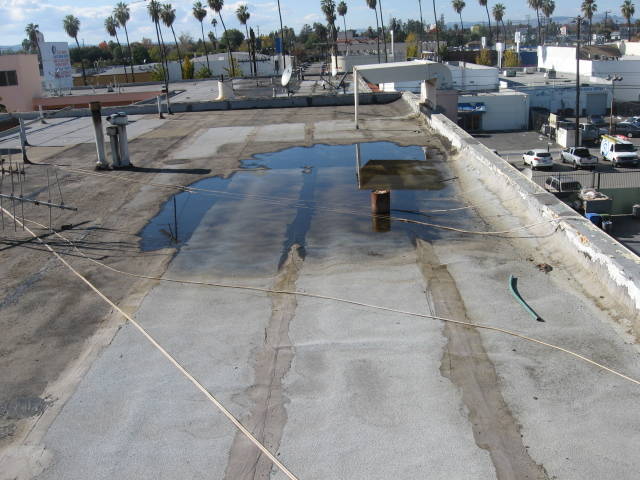Schedule Free Estimate
How To Fix Roof Ponding
If you have a flat roof then you already know what the most common problem for flat roofs is. Ponding. Sometimes it’s easy to think that all
ponding is bad but if you have sitting stagnate water after a rainstorm for 12-36 hours and then dissipates that is completely normal. However, if
the water is still after 36 hours, then you do have a problem. Fixing it can be tricky so let’s dive right in.
Overcoming the Problem of Roof Ponding
Water. With as much as we rely on it in our daily lives, it’s hard to believe that it’s also one of nature’s most destructive elements.
Perhaps that’s why when so many see it accumulating in areas where it normally shouldn’t, they don’t think anything of it until it becomes too late.
One area where gradual water ponding can become an enormous concern is on your commercial roof.
Flat surfaces can provide ideal conditions for roof ponding, even with drainage systems installed. Over time, several different factors can result in
water accumulating into large puddles on your roof, the results of which you and your employees may eventually feel by drops of water falling on
your head, which then can progress into extensive structural damage.
What Causes Ponding?
Yet how are you to know if roof ponding is an issue affecting your building? The obvious answer is that you need to get up on the roof.
Once there, if you notice any large or small puddles, the next step is to try and determine what may be causing them. There are a number of
different reasons why ponding may happen, including:
• Deteriorated insulation: If you walk on your roof a lot, the foot traffic can cause the insulation underneath it to deteriorate. This can lead to indentations that will eventually allow water to accumulate.
• Structural issues: Foundation issues or worn ceiling beams can lead to uneven areas on your roof, which could ultimately result in ponds.
• Roof protrusions: Protrusions that result from HVAC units and skylights can contribute to ponding because they disrupt the flow of water across the roof.
• Drainage issues: Blocked drainage pipes or improperly installed drains and scuppers can easily fail in draining water away from your building, causing it to remain and pool.
How to Fix Roof Ponding
Whatever the cause may be, once you notice ponds on your roof, finding the source and fixing them can be quite tricky so the best way to fix it is to hire a professional roof contractor.
But don’t just hire the first or lowest cost roofer (as tempting as that may be) as that could be more costly than the ponding itself. Do your research and take your time. If you’re interested
check out this guide I wrote for tips on hiring the right roofer.
Often, a simple inspection will reveal the root causes of the ponding and allow for a quick repair. For example, removing loose granules from a
the granulated roof can stop drain buildup.
Simple leaks coming from drain lines or AC units can also be remedied fairly quickly.
If more complex issues are discovered, your roofing provider may suggest more extensive repairs such as:
• Performing a drainage flush or adding more drain lines
• Incorporating roof crickets to help divert water away from uneven areas
• Completely re-pitching the roof
You count on your commercial roof to protect your workforce as well as your day-to-day operations. Why let something as seemingly small and
insignificant such as a puddle of water interfere with that? It won’t if you recognize and address it in time.
Central Roofing Company Headquarters
555 W. 182nd Street
Gardena, CA 90248
310-527-6770

Get A Quote
One of our roofing estimators will gladly meet you to discuss your options and follow up with a free, no-obligation, written estimate.
At Central Roofing Company, we understand that a sturdy and reliable roof is crucial for the success and safety of your commercial property. Our team of highly skilled and trained roofing professionals is committed to delivering exceptional craftsmanship and superior service in every project we undertake.
555 W. 182nd St. Gardena, CA 90248
Ph: 310-527-6770
Our Office Locations:
Our Services
CA license #684960 – Central Roofing, 2024 ©All Rights Reserved | Terms of Use | Privacy Policy | Built by Dymic
